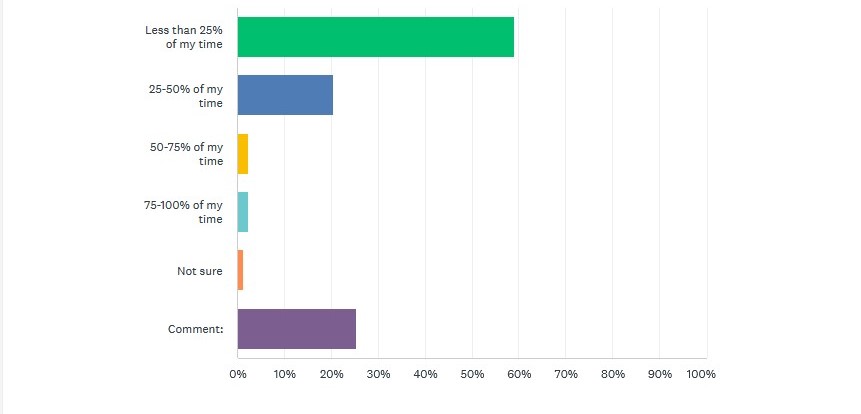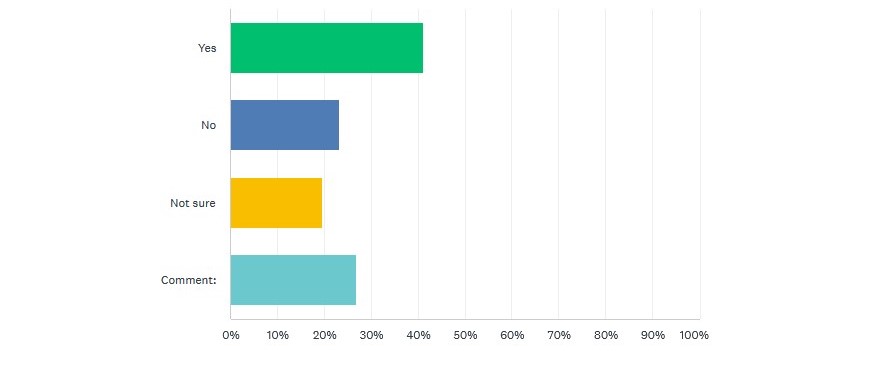In recent school years, there has been increased attention on the national substitute teacher shortage and its impact on teachers, students, and families. A significant piece of that story that has not received as much attention is the impact of that shortage on English language learners (ELLs) and English as a Second Language (ESL) teachers nationwide.
ELLs and educators of ELLs have continued to face a complex constellation of challenges during the COVID-19 pandemic. After schools returned to in-person learning in the Fall of 2021, however, the impacts of the national substitute teacher shortage began snowballing, with profound impacts on ELLs and ESL teachers alike.
Teacher voices from the field
 In order to learn more about this issue, Colorín Colorado launched an anonymous survey in November of 2021, sharing the survey through its social media channels and its newsletters. Many educators also shared the survey with their own networks. Over the next three months, nearly 100 educators from 18 states responded to the survey. More than 80% identified themselves as ESL teachers and 14% identified themselves as ELL coaches or administrators. Other respondents included classroom teachers, bilingual teachers, and paraprofessionals.
In order to learn more about this issue, Colorín Colorado launched an anonymous survey in November of 2021, sharing the survey through its social media channels and its newsletters. Many educators also shared the survey with their own networks. Over the next three months, nearly 100 educators from 18 states responded to the survey. More than 80% identified themselves as ESL teachers and 14% identified themselves as ELL coaches or administrators. Other respondents included classroom teachers, bilingual teachers, and paraprofessionals.
Colorín Colorado then invited Dr. Diane Staehr Fenner from SupportEd, who has written extensively about ELL advocacy, to review the data and write a summary of results.
We would like to thank Dr. Staehr Fenner for her careful and thoughtful review of this data and also thank all of the educators who have shared their experiences with us. We know that this is a deeply challenging time for educators, administrators, students, and families, and we hope that this article can lead to some constructive, productive conversations in the short and long term around this critical and complex issue.
What's in this article
This article includes:
- a brief examination of the overall context related to the national teacher shortage and substitute teacher shortage
- educators' own voices explaining how the substitute teacher shortage is impacting ELLs and teachers of ELLs
- some practical examples of steps educators have taken to alleviate the situation
- insights from educators in districts that have been working on this issue through creative, systems-wide approaches
The National Teacher Shortage
To better understand the current substitute teacher shortage, it's helpful to first widen our lens and look at the teacher shortage in general. As a 2021 Washington Post article states, there is a teacher shortage in every state across the country that is "a century in the making." Some of the ways that understaffed schools have typically addressed this shortage include hiring long-term subs and emergency licensed teachers. As with many aspects of the COVID-19 pandemic, the issue of teacher shortages in general has been exacerbated over the past two years as teachers' responsibilities have increased (often without additional pay), with many choosing to retire early or leave the profession altogether.
The ESL teacher shortage
Within the general teacher shortage, there is also a shortage of ESL teachers in the majority of states in the U.S.
According to the U.S. Department of Education's Teacher Shortage Area Data database, thirty-three states and the District of Columbia reported statewide ESL teacher or specialist/consultant shortages in 2021-22.
The substitute teacher shortage
The substitute shortage was also a problem long before COVID-19 and is now at the breaking point. According to an EdWeek survey published in October 2021 (before the Omicron variant), more than 75% of administrators reported they were facing difficulty finding enough substitutes.
The situation is dire and has only worsened during Omicron. Districts across the country have called upon educators, intervention specialists, principals, district staff, and district leaders to cover classes, among other responsibilities, and some principals and superintendents have taken on other duties as well, such as getting special licenses to drive a school bus.
Districts have invited parents and even National Guard members to substitute. They have also hired virtual substitutes and have used numerous strategies to address the coverage issue, including:
- combining classes
- shortening the school day or school week
- temporarily returning to virtual learning
It's become the perfect storm: an existing teacher shortage coupled with a lack of substitute teachers during a surge of teacher absences due to illness from (or exposure to) the Omicron COVID variant.
How equipped are schools to serve ELLs?
There are additional factors that impact how these shortages are playing out in schools serving ELLs across the country, including:
- state, district, and school policies
- how well-equipped districts and schools are to provide ELLs with the services to which they are legally entitled
- how familiar the district and school leaders are with those legal requirements
- what kinds of language instruction models are used and how staff schedules are set up
- how well administrators and colleagues understand the ESL teacher's role, expertise, and specialized skill set
- how proactive leaders are in optimizing conditions for ELLs to access instruction even as circumstances evolve during COVID-19
Survey Findings
Now that we've reviewed the overall context, let's narrow our focus to Colorín Colorado's survey responses. The participants overwhelmingly agreed that their school or district has a substitute teacher shortage, with nearly 97% stating there was a shortage.
More than 60% of respondents stated that they were being pulled from their assigned classes to cover others' classes due to not having enough substitute teachers in their school (Figure 1). Of those who responded that they were covering other teachers' classes, more than half shared that they were covering classes less than 25% of their time, and twenty percent responded they were spending 25-50% of their time covering their colleagues' classes. A very small number said that they were covering classes 50% or more of their time.
In addition, 45% of coaches and administrators indicated that ESL teachers are being pulled from their assigned classes to cover other classes at a disproportionate rate to other staff members (Figure 2).
Figure 1. Estimates of time ESL Teachers report being pulled from their assigned classes to cover other classes

Figure 2. Administrators who report that ESL teachers are pulled disproportionately to cover other classes

Impact on ELL Students
 While these numbers speak volumes, the educators' voices that describe this situation are especially poignant. Several themes rose to the surface when analyzing the comments that teachers included in their survey responses.
While these numbers speak volumes, the educators' voices that describe this situation are especially poignant. Several themes rose to the surface when analyzing the comments that teachers included in their survey responses.
I will first describe the impact of the substitute teacher shortage on ELL students, and I will then then take a deeper look at the impact of these increased demands on ESL teachers themselves.
The most noted areas of impact of the substitute teacher shortage on ELLs are:
- ELLs missing ESL instruction time
- ELLs receiving inconsistent instruction, often in classrooms being covered by substitute teachers in general education or content classrooms
- students' confusion and stress being felt as a result of changes to their classes and schedules
1. Decreased targeted ESL instructional time
ESL Teacher Voices
"My ELLs are suffering from inconsistent support, and it is troubling. I don't feel I can build solid relationships with them and truly be the resource they need."
Multiple ESL teachers shared that, due to them getting pulled to cover other classrooms, their ELLs are not getting the ESL services they are entitled to. In particular, many teachers noted that ELLs are not receiving small group, targeted language instruction at a time when academic pressures are especially high.
One teacher described the disconnect between gaps in learning and the current reality of covering classrooms by saying, "We are being told how much our ELLs need to catch up and yet I am constantly pulled. This disrupts group time…and planned lessons are thrown out the door."
Another ESL teacher noted that they only usually see students once a week in a small group, and when the teacher is pulled from that small group to cover another class, there are "big gaps in services." One ESL educator seemed to indicate that all intervention and Title I groups have been cancelled for the time being in their building. Another teacher wrote, "Groups don't get pulled (and) the neediest children lose access to targeted learning."
In addition, many respondents mentioned how crucial the need for targeted, consistent ESL instruction is for newcomers in particular. One educator noted that even prior to the pandemic, ELLs at lower English proficiency levels in their school were not provided consistent ESL services, which had long-term repercussions for students. Another educator shared, "The ELLs that should be getting more support than classroom instruction and small groups are getting none, including our newcomers," echoing the teacher who wrote, "I have several newcomer students who really need the support."
2. Inconsistent instruction of ELLs in general education or content classes
ESL Teacher Voices
"Inconsistency in the classroom is a big problem. (ELLs) need consistent and regular teachers and classroom situations and that just isn't the case right now."
Educators frequently reported that ELLs are often being taught in their general education or core content classes by short-term substitute teachers, long-term subs, or non-certified colleagues. Some educators noted that, with this arrangement, substitutes who don't have experience in working with ELLs are often covering classes and "don't get told which students are ELL and which languages they speak." Substitutes themselves may be reluctant to work with ELLs if they don't have ELL experience; one educator wrote, "Often it is hard to find substitutes who are...willing to work with students of other languages."
One educator noted that some of their ELLs have grade-level or content classes with non-certified long-term subs "for months" and that these students do not receive ESL services. Another educator shared, "There's already minimal language instruction happening and, with subbing, there is no consistent teaching happening."
Multiple respondents used the term "inconsistency" to describe what is happening in their context, with the routines needed to reinforce language skills being interrupted. In addition, two respondents mentioned overcrowding. One teacher noted, "They are missing their small group ESL instruction; they are in over-crowded classrooms because of split classes due to no subs," while another wrote, "ELLs are being placed in classes with huge student-teacher ratios."
3. ELL students' stress, confusion, and changing behaviors
Many of the respondents shared that the changes described here have also had significant impacts on students beyond missed instruction time.
Multiple ESL educators noted that their ELL students seemed markedly more confused this school year, feeling "more stress in all classrooms." One shared, "Many are confused in their content classes and have a lot of questions about why I didn't see them [to provide ESL services]." Some teachers made the direct connection to ELLs not receiving mandated ESL instructional time and its effects on their English language acquisition, writing that their language acquisition is "suffering and they are not being fully supported. This is making them stressed and shutting down." Another educator shared that their ELLs feel anxious and unable to receive the academic and language support that is crucial in their academic success.
Other educators described how ELLs might be interpreting their reduced contact with their ESL teachers, writing "They often feel sad that the EL teacher didn't come to meet with them. It's another disruption." This sense of loss and confusion is especially felt by younger ELLs: "The little ones are so confused that they see you in the [school] building but you didn't see them [to provide ESL services]."
Finally, one educator notes that this instability that comes from being moved around to different classrooms and having several different, unexpected teachers in one day "hits ELLs even harder than other students because they don't always understand what's happening, and they rely on routine to feel safe and secure." It's worth noting that the ESL teacher may be one of the primary adults that ELLs rely on most in the school and these disruptions in consistency can be particularly difficult for students to navigate and understand.
Social-emotional impacts
The social-emotional impact of these trends is also noticeable. One teacher noted that because their students do not have consistent instruction from their certified classroom teachers, "behaviors are amped up from the number of classrooms without proper, consistent supervision." Another ESL teacher shared that they have to refresh students on classroom routines and focus more on student behavior management as the teacher spends less and less time with their ELLs due to subbing for other teachers.
Impact on ESL Teachers
 In addition to describing how the substitute shortage has affected their ELL students, ESL educators shared multiple ways in which the substitute shortage has affected their work with students and colleagues, as well as their perspectives on their role and their future in the profession.
In addition to describing how the substitute shortage has affected their ELL students, ESL educators shared multiple ways in which the substitute shortage has affected their work with students and colleagues, as well as their perspectives on their role and their future in the profession.
Some of the biggest impacts they detailed include:
- reduced time with ELLs
- less planning time
- less time for collaboration and co-teaching
- impacts on other caseload responsibilities
- concerns about equity
- high levels of stress, anxiety and frustration
- exhaustion and burn-out
- reluctance to be absent, even when sick
- low morale
- thoughts of leaving the profession
1. Reduced time with ELLs
As teachers reflected on the impacts of their substitute teaching load, they wrote repeatedly about the reduction in time with their students. One teacher noted, "I am asked to teach a class when I am meant to be pushing in to specifically work with ELLs. While this...reinforces my role as a teacher of all the students, it takes away from ELL instruction."
Another teacher wrote, "I spend a lot of time covering classes, so I don't get to work with my ELs regularly," while a different teacher described how lessons and units are cut short and rushed, sharing, "I have anxiety about it every day." And another noted that some assignments were full-day assignments: "This really just depends on the day and who is out that I am covering. When I'm asked to sub, it is usually for the entire school day."
2. Less planning time
ESL teachers' coverage of other classes also impacts their own planning time. One educator wrote, "I have almost no planning time anymore because I'm often pulled in to sub for an hour or two. My students are seeing me less and the teachers I'm working with feel less supported." Another wrote, "Currently both [my coworker and I] are forced to cover at least two periods a day. We sometimes have to give up our prep period to make sure our students receive services."
ESL educators also noted that they often plan lessons that won't be used because they may be called to sub at any time. For example, one educator noted, "It's also hard to stay motivated when you are constantly pulled to sub," while another wrote, "I plan lessons for my small groups of ELs, yet when I come to work, I get an email that says I must cover for another class."
One teacher describes planning as "inconsistent" with units being interrupted, and another educator noted that it's difficult to plan for the substitutes who may be covering their classes at the same time.
3. Less time for collaboration with colleagues and co-teaching
Many teachers also wrote about the impact of these assignments on their ability to collaborate with colleagues. One teacher wrote, "Without knowing if I'm going to be pulled, I can't coordinate with my teachers. My kids have to come for help before and after school since I miss them during the day."
In addition, teachers wrote about disruptions to co-teaching arrangements with other colleagues. One teacher wrote, "It is extremely stressful for me to be pulled. Usually, I don't know until the morning of and then last minute I'm looking at sub plans if there are any and my groups and co-teaching is cancelled." Another echoed that same concern for colleagues in co-teaching situations with this comment: "They don't get their small group time with me and my co-teachers are left hanging if I'm not there."
Interestingly, one teacher was able to use the impact on co-teaching arrangements as a bit of leverage when trying to address the issue: "I had a discussion and explained that since I am co-teaching, I am leaving that teacher hanging and having to scramble to come up w/ Plan B for that time."
4. Impacts on other caseload responsibilities
All the while, ESL teachers are still expected to complete the necessary paperwork for their student caseloads while playing catch up with students during their lunch periods or after school. This may be on top of overseeing the administration of time-consuming English language proficiency assessments, which in some districts also occupied multiple weeks (or months) of ESL teachers' time at the beginning of the school year.
Subbing assignments impact ESL teachers' ability to fulfill those responsibilities too. One teacher wrote, "When I'm pulled to sub, it not only deprives ELL students and classroom teachers of lessons and activities that I would have led that day, but also takes time from case management duties, too."
Another teacher explained, "We are pulled from our work of building an ELL Department at the district level — infrastructure that is desperately needed to serve students and their families."
5. Concerns about equity
In addition, many teachers wrote about their concerns and frustration about inequitable conditions for their students. One teacher wrote, "When we are pulled, it feels as of our roles are less valued than other teachers and that our students' needs are not an educational priority." Another wrote, "(I am) feeling stress about not advocating enough and that language needs don't hold high value in the district. Words and actions don't match."
Others described the frustration that these issues were not prioritized in their setting, and that schools' legal obligations to ELLs were not more of a driving force in managing staffing decisions. One teacher wrote, "I feel that the substitute teacher shortage and the teacher shortage in general is preventing students from getting the services that they are legally entitled to. 15-20 minutes of service a week does not seem adequate. I also am concerned because parents are not aware of the extent of the impact that the shortage is having on their kids' education."
Another teacher echoed that same concern, writing, "We are breaking our legal obligations to ELL families. Parents sign for language services and they're not happening...Families need to be informed."
6. Reluctance to be absent, even when sick
A few of the respondents also wrote that they are going to great lengths not to be out sick themselves since their ESL classes typically have not been covered with substitutes when they are absent. One teacher said, "I never have a substitute if I am out," while another wrote, "It makes me feel like I can't be out, and in the middle of a COVID outbreak, that's not a safe feeling, either."
Some teachers shared the impression that ESL classes have been a low priority when they see other classes getting substitutes instead of ESL classes being covered. One teacher wrote, "I've seen that teachers who are sick or burned out are very hesitant to call in sick (even if they need to) because they know their students most likely won't get services that day because the few subs are allocated to 'classroom' teachers."
And one teacher reflected on her upcoming maternity leave, stating "My students will not have a substitute while I am on maternity leave. They will lose a lot of time, receive less than their already low mandated time, and be (inappropriately) grouped for pull-out instruction." She predicted, "My students will suffer and it will impact me when I return."
7. High levels of stress, anxiety, and frustration
It is not surprising that based on all of the circumstances described above, many of the respondents described how these challenges and coverage assignments have increased their stress in many ways.
ESL Teacher Voices
"Being pulled to sub adds a significant amount of stress to my day. Going to work every day not knowing where I will work makes it challenging to remain motivated and positive, as well as dedicate time to planning lessons that I know will get interrupted due to subbing."
Uncertainty, anxiety, and stress
Many teachers reported that sustained uncertainty was contributing to an increase in anxiety, especially when educators' assignments regularly change at the very last minute. This is captured in the following comments:
- "I have to look at my phone every morning to see if I will be teaching my class or another."
- "It makes me anxious to come to work. I never know exactly what I'm doing or if I'm going to get pulled to sub with no warning."
- "Every day I'm nervous as I enter the building hoping I can do my job each day!"
- "I have to make up assignments on the fly...It adds more stress to my job."
Other teachers described the stress they felt by not being able to meet their own obligations, such as the teacher who wrote about the stress they feel from "letting students and other teachers down." Another wrote, "It also makes me feel frazzled and anxious because I am not prepared to cover classes other than what I was hired for."
Frustration
Other teachers described a deep sense of frustration, such as the teacher who wrote, "[I feel] frustration of not getting to do the job I have and [not being able to] connect with students." Another echoed those comments, writing, "It is frustrating to not be able to do your job," while yet another summed it up by saying, "Words cannot emphasize enough how frustrating the sub shortage has been."
8. Exhaustion and burn-out
In addition, multiple teachers wrote that they are "exhausted," "overwhelmed," and "burnt out." One teacher wrote, "[I am] constantly...behind on my planning and where I need to be with my lessons," while another said, "It is extremely draining and stressful. We seem to be going from one crisis to another. I don't see this as being sustainable this year or beyond. I do not want to be subbing constantly for the rest of my career and feel like my students' needs are not being met." Another teacher talked about the workload of preparing their own classes and classes that they would be covering, writing, "It is exhausting...Double prep. Double work." Another teacher wrote, "Exhausted. No break or planning time during the day. Not sustainable."
And one teacher reflected on the larger impact of these assignments with this comment: "It takes time away from working with ELs. It also just has everyone more tired and exhausted than usual. We end up working our prep, lunch, before and after school due to the shortage. This is why we have to work so many hours outside of the regular school day to do our jobs as far as planning, paperwork, etc."
9. Low morale
Throughout the survey responses, ESL also educators described low morale and a perceived lack of respect and appreciation for their role in their setting. Educators used words like "undervalued" and "demoralized." One teacher wrote, "It makes me feel undervalued, like my job doesn't matter."
One educator noted that administrators' actions speak louder than words, writing, "Loudly hearing the message that my work isn't valued and that equity is not really what we want, even though we use the word." Another teacher shares, "I feel demeaned, undermined, and disrespected. It's obvious that our administration considers me and other EL teachers the least important in the school." An additional educator noted the lack of remuneration, writing, "It also hurts that others are paid to sub while Title and EL teachers are not." Another teacher shared that they have many main office staff who are licensed teachers that could be available to sub, but they are not included as part of the in-house substitute pool.
10. Thoughts on leaving the teaching profession
Finally, the most permanent implication of the substitute teacher shortage on ESL teachers is that this situation seems to be the final straw in forcing some teachers to make a difficult decision. Several teachers shared that they are considering leaving teaching altogether, as seen in these comments:
- "I'm thinking about leaving my role."
- "I'm not sure how much longer I can keep this up and it's making me consider leaving the profession after this year."
- "It has been extremely demeaning and is making me quite depressed to sub 1-2 days a week. I am thinking seriously about early retirement."
- "I am stressed. I don't feel effective as a teacher, nor do I know if I will continue teaching without more infrastructure to support our profession."
Action Steps: Ideas from the Field
 Before reading further, I encourage you to take a moment to let this all sink in. The testimonials from the educators above show the depth, breadth, and complexity of this issue, as well as the serious consequences for students, educators, and the ESL profession if these issues remain unaddressed.
Before reading further, I encourage you to take a moment to let this all sink in. The testimonials from the educators above show the depth, breadth, and complexity of this issue, as well as the serious consequences for students, educators, and the ESL profession if these issues remain unaddressed.
There are some rays of hope, however. In addition to these testimonials captured above, I also found some helpful examples within the survey responses from educators who have been able to make a difference in their setting. Those examples are woven through the next section, along with other expert advice for educators who wonder what steps they might take in addressing this issue.
1. Documenting the issue
One critical first step for educators is to carefully document all of their substitute assignments, keeping notes about:
- how often they are subbing
- what kinds of classes they are covering
- who asked them to cover the class
- dates and times of coverage
- the impact of that coverage and lost instruction time on ELLs
- the impact of lost administrative time
- the impact of lost planning and collaborative time on instruction and co-teaching arrangements
Educators can do this on an individual basis, but they may also wish to work with other ESL colleagues or teachers with whom they collaborate or co-teach to document these trends as a team to show broader impacts of their assignments.
In addition, teachers may wish to:
- speak with other ESL teachers in the school or district to determine the scope of the problem
- connect with other ESL educators in other districts to learn what the situation looks like in their setting
- consider how well colleagues and school/district leaders understand the ESL teacher's role and what ESL services offer (and whether this is an area where some professional development for the school staff might help)
- share this article as a conversation starter and use the reflection questions below to guide your discussion
Note: In conversations with teacher's unions about this issue, staff who are working on the teacher shortage issue strongly advised against refusing to comply with substitution assignments, as this could have negative impacts for a teacher.
2. The role of unions
The local teacher's union may also have helpful resources. Some respondents to the survey described how they've collaborated with their unions, including in the following examples:
- After making little progress on a discussion about evenly distributing subbing among all licensed staff and providing extra compensation to current teachers for subbing, a group of educators decided to contact their union reps to discuss solutions.
- Another educator described how their union wrote a Memorandum of Understanding which included a prescribed procedure for having staff substitute when no substitute is available.
- Some educators noted that they had representatives from their teacher's union in attendance when they presented ideas to administrators.
One educator shared, "Some met with school board members and the teacher union and pointed out that this was inequitable. We came up with a plan to have other specialists share the load. Also, administrators assigned two permanent substitutes and cut back on daytime trainings to prevent demand for substitutes." (Another educator also reflected that their meetings with school board members were also beneficial in raising awareness and gaining support.)
In addition, one EL teacher in St. Paul, MN shared that the St. Paul Federation of Teachers played an important role in addressing this issue district-wide. She wrote, "Even though we'd asked the district to change their policy (and they did — the EL department said we should not be repeatedly and unequally used as subs), it was still happening, so we decided that putting it in the contract gave everyone access to what the expectations were. Then we extended it to include substitutes working in EL jobs, because our subs were always being reassigned, so we felt like we couldn't be absent because then our kids wouldn't get support."
3. Understanding if any specific policies are playing a role in assignments
It can also be helpful for educators to further understand what school or district policies might be impacting staffing assignments. For example, one teacher noted that their administrator's support limited their substitution assignments, writing, "I am thankful that in my school my administrator is supportive and rarely calls on me for this unless in dire emergencies."
Sometimes, however, other factors are at play, such as in this example from a teacher: "Administrative discussions have occurred, but HR has labeled ELD teachers as 'allowable' to be pulled for subbing. The same is not true for special education staff. There is a disconnect between HR and what is legally required when it comes to our English language development program."
4. Increasing awareness of schools' legal obligations to ELLs
This prior example speaks to another approach some educators are trying, which is expanding overall understanding of the laws related to ELLs. A few respondents mentioned that their schools know special education laws much better, which is a common refrain in ELL circles, although it's important to note that one respondent shared that special education paraprofessionals have been pulled to cover in their district and special educators are also being pulled to substitute and cover classes around the country.
An educator noted the following: "I researched the situation thoroughly and pulled up case law and share that with administrators. I showed how the federal government might order non-compliant schools to spend X amount of hours working with the ELL students and share how if we were reported, we would have to come up with a similar schedule and reporting system. It took about four meetings to get them to change how they treated us...All school staff, including front office, need to be trained in the law as it pertains to ELLs."
And just to highlight how much higher the stakes may be than districts realize, one educator wrote "(ESL teachers being pulled as substitutes) has happened in past years, but given a DOJ settlement in my county, it's now avoided. There are potential legal ramifications with an audit should our EL students not receive their designated hours."
In addition, it's worth noting that schools who have embraced a school-wide commitment to educating ELLs have benefitted from that approach during this difficult time. For example, we did hear from one elementary school leader in a Title I school who has a high number of ELLs and ESL-certified staff based on district requirements. This leader shared that the school has used a rotation schedule for coverage and that the staff's solid preparation for working with ELLs has led to fewer disruptions in students' learning since so many people are equipped to support ELLs' instruction. I
5. Brainstorming possible solutions to the substitute shortage
 Survey respondents also included ideas on addressing the substitute shortage. These suggestions fell into general categories of enticing current staff through payment, thinking more creatively about scheduling, and looking to the community.
Survey respondents also included ideas on addressing the substitute shortage. These suggestions fell into general categories of enticing current staff through payment, thinking more creatively about scheduling, and looking to the community.
Some ideas related to first looking at the expertise already within school buildings included:
- offering more money to paraprofessionals
- encouraging them to obtain substitute teacher licenses
In addition, two teachers noted that their school pays teachers extra when they voluntarily cover a class during their planning period. One teacher notes, "Teachers are more likely to sub...when they are being compensated for their time. We have a list of teachers who consistently volunteer, and then they send district-wide emails to see who wants a class for pay."
Some educators made suggestions that did not involve extra compensation, such as pulling teachers from hall or cafeteria duty. Another educator recommended broadening the rotation of teachers and dividing sub assignments in half so that no teacher misses a full day in their own classrooms.
In addition, some educators shared the following ideas:
- "(We are working) hard to recruit bilingual parents and neighbors in the community to apply for substitute positions."
- "The best thing my school did this year was to hire a full-time, in-house sub. We now always have one extra teacher to fill in anywhere needed. It has eased the burden some."
- "Going virtual helps alleviate the need for as many subs when teachers are feeling well enough to work but can't come back due to COVID restrictions."
Additional ideas
 Additional short-term and long-term ideas include the following:
Additional short-term and long-term ideas include the following:
- Paying student teachers to cover their partner teachers' classes
- Providing comp time or pay to teachers who sub during their planning periods
- Actively recruiting college students at community colleges and college students home on break
- Looking to parents, community members, and retired teachers to fill in the gaps in the substitute teacher pool
In addition, districts could consider temporarily making the process and requirements easier to become a sub while still maintaining high standards for personnel. On a personal note, I have inquired at my local district about becoming a sub. One of the many requirements is that I provide all college and grad school transcripts. Since I once worked in this district, I emailed to see if they still have my records on file from my ten years of employment. I have not heard back and have followed up multiple times.
6. Engaging administrators
Finally, it is possible that meeting with administrators collegially to raise the issue can help make headway. In some cases, informal conversations may be enough to get the ball rolling. Whether it's a formal or informal conversation, however, it's critical to be well-prepared for these conversations and consider:
- who should be present at the meeting
- what information and data would help support your case
- what talking points you wish to present
- what your potential solutions might be, anticipating any pushback you may receive
This ELL leadership action plan underscores how beneficial it is to come prepared with plausible options for administrators to review. Acknowledging the strains and stresses that everyone is under can also help the conversation get off to a better start.
And, of course, it is also possible that your initial efforts may meet resistance within a climate in which all educators are stretched — even in districts where the ELL programming and family outreach is fairly robust. Don't give up, however. Continue documenting the impacts of the issues you are concerned about, talking with colleagues, and considering other steps to try. It is possible that there may be another time to raise these issues in the near future when some of the current COVID surges have subsided — and the very least, you will have started the conversation.
Related resources
These ELL advocacy tools can also support your planning:
- Our New Normal: How ELL Educators Are Advocating for Our Students and Our Profession During COVID-19 (Colorín Colorado)
- All In! How Educators Can Advocate for English Language Learners (National Education Association)
Reflection/Discussion Questions
 As all of this sinks in, you can use the following questions for your own reflection, for discussion with colleagues, or for a collaborative conversation within a professional learning community.
As all of this sinks in, you can use the following questions for your own reflection, for discussion with colleagues, or for a collaborative conversation within a professional learning community.
Feel free to add your own questions when sharing with colleagues!
Questions
- How is the substitute shortage impacting ELLs and ESL teachers in your district?
- How aware are school and district leaders of those impacts?
- How is it impacting you?
- How is it impacting your ELLs?
- What is something from this article that resonated with your experience?
- What are some of your biggest takeaways from this article?
- What is a single step that you could take after reading this article to address this issue?
Closing Thoughts
Our hope in highlighting this challenge and sharing so many educators' voices is to begin a conversation that can lead to positive change, connecting educators who are struggling with sufficient support while still ensuring ELLs get the services they are legally entitled to. Small steps can make a big difference in the long run, and ESL educators are a tremendous asset who can play a critical role in shaping conversations as well as future policy. For those of you who need reminders of those strengths, take a look at the following resources:
- Strengths of ESL Educators During COVID-19
- You Are Already a Leader: Identifying Your Leadership Skills on Behalf of ELLs
We also wish to send a message of encouragement to all of the educators, administrators, and school staff who are struggling during this difficult time. Thank you for your hard work and for all you are doing to support your students each day.
About the Author
Diane Staehr Fenner, Ph.D., is the president of SupportEd and founded the company in 2011 as a way to serve educators who work to help multilingual learners (MLs) realize their full potential. Dr. Staehr Fenner is an author of six books (including Culturally Responsive Teaching for Multilingual Learners: Tools for Equity, Unlocking English Learners’ Potential: Strategies for Making Content Accessible, and Advocating for English Learners: A Guide for Educators). She is a frequent keynote presenter on ML education at conferences across North America and has contributed to multiple blogs, including the Colorín Colorado blog.
She spent a decade as an ESOL teacher, dual language assessment teacher, and ESOL assessment specialist in Fairfax County Public Schools, VA and taught English in Mexico and Germany. She earned her Ph.D. in Multilingual/Multicultural Education with an emphasis in Literacy at George Mason University. She earned her MAT in TESOL at the School for International Training and her Masters in German at Penn State University. She lives in Fairfax, VA with her husband and three school-age kids who learned math and science through Spanish in their public elementary school. Dr. Staehr Fenner grew up on a dairy farm in New York State’s Finger Lakes region and is a first-generation college graduate.









Add new comment